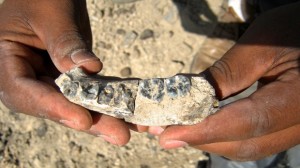A fragment of jawbone found in Ethiopia is the oldest known fossil from an evolutionary tree branch that eventually led to modern humans, scientists reported Wednesday.
The fossil comes from very close to the time that our branch split away from more ape-like ancestors best known for the fossil skeleton Lucy. So it gives a rare glimpse of what very early members of our branch looked like.

At about 2.8 million years old, the partial jawbone pushes back the fossil record by at least 400,000 years for our branch, which scientists call Homo.
It was found two years ago at a site not far from where Lucy was unearthed. East Africa is a hotbed for human ancestor fossils, and scientists from Arizona State University have worked for years at the site in northeast Ethiopia, trying to find fossils from the dimly understood period when the Homo genus, or group, arose.
Our species, called Homo sapiens, is the only surviving member of this group, and appeared about 200,000 years ago. Until now, the oldest known remains from the human genus were about 2.3 to 2.4 million years old and from the species Homo habilis.
The jaw fragment, which includes five teeth, was discovered in pieces one morning by Chalachew Seyoum, an Ethiopian graduate student at Arizona State, just 64 kilometres from where Lucy was discovered. He said he spotted a tooth poking out of the ground while looking for fossils.
The discovery is described in a paper released Wednesday by the journal Science.
Zeroing in on 1st Homo species
Arizona State’s William Kimbel, an author of the paper, said it’s not clear whether the fossil came from a known early species of Homo or whether it reveals a new one. Field work is continuing to look for more fossils at the site, said another author, Brian Villmoare of the University of Nevada, Las Vegas.
“Although it is probably a new species, we are awaiting more material before definitively naming a new species,” said Villmoare.
Analysis indicates the jaw fossil came from one of the earliest populations of Homo, and its age helps narrow the range of possibilities for when the first Homo species appeared, Kimbel said. The fossil dates to as little as 200,000 years after the last known fossil from Lucy’s species.
The fossil is from the left lower jaw of an adult. It combines ancestral features, like a primitive chin shape, with some traits found in later Homo fossils, like teeth that are slimmer than the bulbous molars of Lucy’s ilk.
The find bolsters the argument that Homo arose from Lucy’s species, Australopithecus afarensis, rather than a related one, said Susan Anton of New York University.
“At 2.8 million years ago, this places the evolution of our genus very close to 3.0 million years ago, which is when we last see Lucy’s species,” Villmoare said.
2M year mark crucial in human development
The Homo genus, especially after 2 million years ago, developed larger brains and tool use and began eating meat.
The landscape where the individual belonging to the jawbone lived probably had few trees except near water, like the modern Serengeti Plains in Tanzania, with abundant grazing animals, hippos and crocodiles, said Penn State University geoscientist Erin DiMaggio.
“If Homo was eating meat, it could have eaten any of the animals, but we don’t know much about that yet,” added Arizona State University anthropologist Kaye Reed. “It was a dangerous place. Saber-toothed cats, hyenas and other large carnivores could have preyed upon Homo.”
A separate study in the journal Nature provided a fresh analysis of a Homo habilis lower jaw from 1.8 million years ago, showing it was unexpectedly primitive and resembled the much older newly discovered jawbone.
Source: AP


